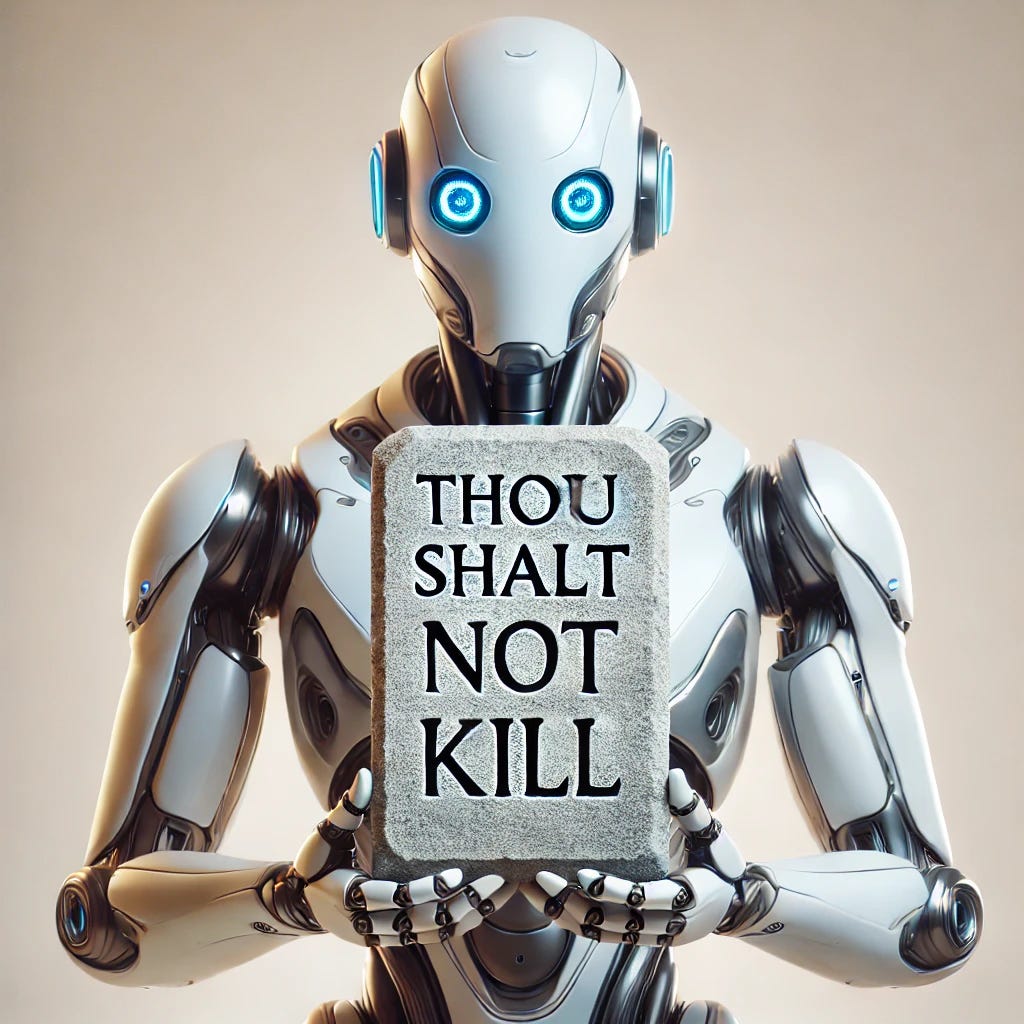Thou Shall Not Kill: Exploring the Concept of Criminal Liability in Robot Homicide
"Thou shalt not kill". This commandment, originating in the Bible, has played a central role in shaping the criminal laws of nations worldwide, serving as the foundation for the prohibition of murder.
Introduction
The commandment, "Thou shalt not kill," has been etched into the moral fabric of our societies, and has been a guiding principle for millennia. This commandment, originating in the Bible, has played a central role in shaping the criminal laws of nations worldwide, serving as the foundation for the prohibition of murder. The concept of criminalizing the taking of human life is deeply rooted in our collective conscience and has helped maintain order and justice throughout history.
However, in today’s rapidly evolving technological landscape, we find ourselves at a crossroads where the age-old "Thou shalt not kill" commandment and the criminal laws against unlawful homicide face an unprecedented challenge – artificial intelligence (AI) and autonomous robots. As these machines become increasingly integrated into our lives and decision-making processes, a pressing question emerges: What happens when a person is killed by AI or robots, and who should bear legal liability for such tragic events?
This is an important question, especially given the incidents where robots have caused human deaths. This article explores how AI-related deaths push the boundaries of long-standing legal principles and ethical frameworks. By examining real-world cases and considering the evolving role of AI in decision-making, we dive into the complexities of assigning legal responsibility when technology becomes capable of causing harm. Can AI be held accountable for taking a life? How do we reconcile this with our deep-rooted moral principles, such as "Thou shalt not kill"? Let's explore these pressing questions and their implications for the future.
What is Homicide?
Homicide is the unlawful killing of a human being by another. According to Black’s Law Dictionary, homicide is defined as “the killing of any human creature. The killing of one human being by the act, procurement, or omission of another.” It encompasses a wide range of acts, from premeditated murder to manslaughter, which can involve negligent or reckless behavior leading to death. Traditionally, homicide involves a human perpetrator who has taken the life of another, either intentionally or through careless actions.
But what happens when the actor is not human? When the perpetrator is an autonomous robot or AI algorithm? This is where long-established legal concepts are called into question, as AI becomes capable of decisions that can lead to unintended – or even lethal – consequences.
The Role of AI: From Tools to Autonomous Actors
In today’s world, AI algorithms are ubiquitous, present in smartphones, self-driving cars, healthcare systems, factories, and even military drones. These systems assist in making decisions that impact human lives on a daily basis. Autonomous robots and AI systems are no longer merely tools wielded by humans, but active agents capable of independent decision-making in complex situations.
In healthcare, robots assist surgeons in delicate procedures, while in the automotive industry, autonomous vehicles navigate roads with little to no human input. In the military, drones equipped with AI are tasked with identifying and eliminating targets. AI-driven systems, due to their ability to make real-time decisions, are increasingly being relied upon to execute tasks that can result in life-or-death outcomes.
AI-Related Fatalities: Case Studies
While AI systems have the potential to improve efficiency and save lives, they also pose risks. Several high-profile incidents have shown the potential for AI systems to cause human fatalities:
Uber's Seld-Dricing Car Incident: In Arizona, a self-driving Uber vehicle struck and killed a pedestrian. The AI system responsible for controlling the vehicle failed to detect the pedestrian in time. This incident led to questions about who should be held responsible – the developers of the AI system, the manufacturers of the vehicle, or the human safety driver present at the time.
Volkswagen Factory Incident (2015): A worker in a German Volkswagen plant was killed by a robotic arm that grabbed him and crushed him against a metal plate. The robot, operating autonomously, was performing routine functions when it malfunctioned. This incident triggered debates over whether the fault lay with the machine, the developers, or inadequate safety protocols.
Medical AI Misdiagnosis: IBM's Watson for Oncology, an AI system designed to assist doctors in cancer treatment recommendations, faced scrutiny after reports emerged that it provided erroneous treatment suggestions. In one instance, it recommended a drug contraindicated for a patient experiencing severe bleeding. Such mistakes underscore the risks of relying on AI in healthcare without adequate human oversight, potentially leading to severe patient harm or fatalities
Autonomous Military Drones: In war zones, autonomous drones have been involved in the deaths of non-combatants. While the drones operate under a set of instructions, their actions can result in fatalities if they misidentify targets or malfunction. The complexity of assigning liability in these cases is compounded by the international context and the involvement of governments and military contractors.
These incidents highlight the potential dangers of autonomous systems. As these technologies become more advanced and widespread, determining liability becomes more challenging.
Legal Responsibility in AI-Caused Homicides
Traditionally, when a homicide occurs, a human perpetrator is identified and held accountable based on intent, negligence, or recklessness. But in cases where AI is involved, assigning legal responsibility becomes a far more complex issue. The following are some possible legal frameworks that could address AI-caused homicides:
Strict Liability for Developers and Manufacturers: Under strict liability, developers and manufacturers could be held responsible for damages caused by their creations, regardless of intent. This would mean that even if an AI system caused harm autonomously, the creators would still be held accountable. However, this framework may not fully address the unique nature of AI, particularly its ability to learn and act independently.
Negligence and Product Liability: Another possible approach is to apply traditional negligence law. This would hold developers or operators accountable if they failed to exercise due care in the design, programming, or oversight of AI systems. Proving negligence would require demonstrating that the harm caused was foreseeable and preventable. However, the complexity of AI systems makes determining foreseeability and liability difficult.
AI as Legal Entities: Some scholars have proposed treating AI systems as legal entities, similar to corporations. This would allow AI systems to bear responsibility for their actions, much like corporations can be held liable for their conduct. This novel approach raises ethical questions about personhood, autonomy, and whether AI systems should be granted legal rights and responsibilities.
Ethical Dilemmas: Can AI Kill?
The ethical questions surrounding AI-caused homicides are profound. At the core of this debate is the question of intent. Traditional ethical frameworks assume that moral agency is a uniquely human trait, requiring an understanding of the consequences of one’s actions. But when AI systems cause harm, they lack intent or awareness – they are simply executing code. Can such systems truly be said to have “killed” in a moral sense?
Additionally, the integration of AI into decision-making processes raises concerns about human oversight. As AI systems become more autonomous, humans may become increasingly removed from life-and-death decisions, allowing machines to act on their own. This challenges traditional ethical beliefs about human responsibility and accountability.
Reimagining Legal and Ethical Frameworks for AI
As AI systems continue to advance, society must grapple with the legal and ethical challenges posed by these technologies. The following are potential paths forward:
Stronger Regulatory Oversight: Governments could implement stricter regulations governing the use of AI systems, particularly in sectors like healthcare, transportation, and defense. These regulations could require extensive safety testing and ongoing monitoring to prevent harm.
Establishing AI Ethics Boards: Companies and institutions that deploy AI systems could be required to establish ethics boards tasked with ensuring that AI systems are designed and used responsibly. These boards could provide oversight and review AI decisions that result in harm.
Public Awareness and Transparency: Companies and governments using AI systems must be transparent about how these systems function and the potential risks they pose. Public awareness campaigns could help educate individuals about the capabilities and limitations of AI, fostering a broader societal discussion about its ethical use.
New Legal Frameworks for AI: Legal scholars and policymakers must work to develop new frameworks that address the unique nature of AI systems. This could involve rethinking liability laws to account for autonomous decision-making and considering how to assign responsibility when AI causes harm.
Conclusion
The commandment "Thou shalt not kill" has been a bedrock of moral and legal systems throughout human history. But in the age of artificial intelligence and autonomous robots, this principle faces unprecedented challenges. As AI systems become more capable of making decisions that can result in human fatalities, society must reimagine how we assign responsibility, enforce accountability, and maintain justice.
The rise of AI presents profound ethical and legal dilemmas that demand immediate attention. Governments, companies, and individuals must work together to ensure that AI is developed and deployed in a manner that respects the sanctity of human life. In doing so, we can uphold the timeless commandment while embracing the technological advancements of the modern era.






